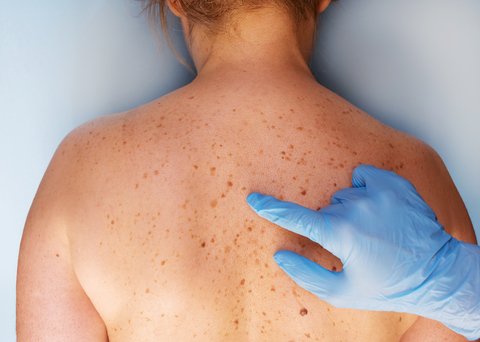Stay safe in your skin!

[vc_row][vc_column width=”1/2″][vc_column_text]May is Skin Cancer and Melanoma Awareness Month.
By this time of the year, typically, April showers have “gone away” and May ushers in the full vibrancy of the sun. At long last, we can shed our outerwear, show more skin, and enjoy the sun shining brightly.
At the same time in May, we have to be more aware and start to be even more careful about protecting our exposure to the sun.
Skin cancer is one of the most common types of cancer. While it may be cured if diagnosed and treated early, it could become life threatening if allowed to spread.
There are three major types:
- Basal cell carcinoma
- Squamous cell carcinoma
- Melanoma
Each of these three is a distinct form of cancer and cannot transform into another type. Early diagnosis and appropriate treatment will result in the best odds for recovery. Regular checks of your skin by a dermatologist should be part of your medical routine.
Skin cancer is the abnormal growth of cells. Basal cell carcinoma is the most common form of cancer worldwide. In the United States, it accounts for approximately 80 percent of all skin cancers. The majority of basal cell carcinomas are easily and successfully treated with current therapies.
Basal cell carcinoma can look different. You may notice a skin growth in a dome shape that has blood vessels in it. At first, a basal cell carcinoma comes up like a small “pearly” bump that looks like a flesh-colored mole or a pimple that doesn’t go away. Sometimes these growths can look dark. Diagnosis can be confirmed with a biopsy.
Treatment of basal cell carcinoma can usually be performed on an outpatient basis and may involve surgery, radiation or chemotherapy.
Squamous cell carcinoma is the second most common form of skin cancer. It most often appears in areas exposed to sun, especially the face and neck, chest, upper back, arms and legs. It is fairly slow growing.
Warning signs include a patch of skin that is rough, scaly, thickened or wart-like. A doctor should also check a raised sore or one that bleeds or does not heal Most squamous cell carcinomas are successfully treated with surgery, radiation or other methods.
Melanoma is the most serious type of cancer and can lead to death.
The first sign of melanoma is typically a new spot on the skin, or a change in the size, shape or color of an existing mole. The ABCDE method may help you determine whether an abnormal skin growth may be melanoma:
- Asymmetry: The mole has an irregular shape.
- Border: The edge is not smooth, but irregular or notched.
- Color: The mole has uneven shading or dark spots.
- Diameter: The spot is larger than the size of a pencil eraser.
- Evolving or Elevation: The spot is changing in size, shape or texture.
The only way to be sure if a mole is melanoma is to have it examined by a doctor.
Other melanoma symptoms may include:
- Sores that do not heal.
- Pigment, redness or swelling that spreads outside the border of a spot to the surrounding skin.
- Itchiness, tenderness or pain.
- Changes in texture, or scales, oozing or bleeding from an existing mole.
Melanoma can spread to other parts of the body so it is important to detect and begin treatment quickly. Type of treatment depends on the stage and location of the melanoma as well as the patient’s general health and may include surgery, targeted radiation therapy, immunotherapy and chemotherapy.
Prevention of skin cancer starts with generous and consistent use of sunscreen with an SPF of at least 30. If possible, avoid sun exposure between the hours of 10am and 2pm and/or wear protective clothing, including a hat. Call your doctor if you notice any new or changing marks as early detection and diagnosis is vital for the best prognosis — a complete cure.
For “au courant” information and to keep yourself educated on Skin cancer and Melanoma, please visit the National Cancer Center website and follow us on social media.
Stay safe in your skin with NCC and enjoy your fun in the sun![/vc_column_text][/vc_column][vc_column width=”1/2″][vc_single_image source=”external_link” custom_src=”https://nationalcancercenter.org/wp/wp-content/uploads/2019/05/dreamstime_xs_132286685.jpg”][vc_single_image source=”external_link” custom_src=”https://nationalcancercenter.org/wp/wp-content/uploads/2019/05/dreamstime_s_128779033.jpg” caption=”Melanoma, a cancer developing from pigment-containing cells melanocytes. Medicine, micrograph.” css=”.vc_custom_1556847846084{margin-bottom: 60px !important;}”][vc_single_image source=”external_link” custom_src=”https://nationalcancercenter.org/wp/wp-content/uploads/2019/05/sunblock-1471393_1920.jpg”][vc_single_image source=”external_link” custom_src=”https://nationalcancercenter.org/wp/wp-content/uploads/2019/05/herson-rodriguez-96113-unsplash.jpg” css=”.vc_custom_1556847738065{margin-top: 30px !important;}”][/vc_column][/vc_row]


